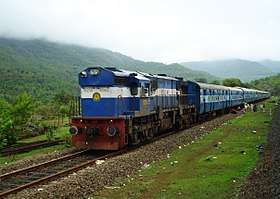Netravati Express
The Netravati Express (16345/46) is a daily express train connecting capital cities of Kerala and Maharashtra. It operates between Thiruvananthapuram Central and Lokmanya Tilak Terminus. The train runs on the Konkan railway.
 Netravathi Express on the Konkan Railway route | |
| Overview | |
|---|---|
| Service type | Mail/Express |
| Locale | Maharashtra, Goa, Karnataka, Kerala |
| First service | 1 March 1998 (changed the route via konkan from Kochi to Kurla)[1] 10 February 2001 (extended to Thiruvananthapuram Central)[2] |
| Current operator(s) | Southern Railways |
| Route | |
| Start | Lokmanya Tilak Terminus (LTT) |
| Stops | 45 |
| End | Thiruvananthapuram Central (TVC) |
| Distance travelled | 1,804 km (1,121 mi) |
| Average journey time | 30 hours 10 minutes |
| Service frequency | Daily |
| Train number(s) | 16345/16346 |
| On-board services | |
| Class(es) | 1 AC 2Tier ,6 AC 3Tier, 10 Sleeper, 2 General, 1 Pantry ,2 End On Generation |
| Seating arrangements | Yes |
| Sleeping arrangements | Yes |
| Catering facilities | Yes |
| Observation facilities | Large windows |
| Technical | |
| Rolling stock | LHB Coaches |
| Operating speed | 47 km/h (29 mph) Average with Halts |
History
Initially the train the Bombay Kurla (LTT) – Mangalore/Cochin Netravati (Cochin – Kurla) Express was plied between Mumbai to Mangalore/Kochi as link via the inland Pune, Gulbarga, Dharmavaram, Krishnarajapuram, Palakkad route parting at Shornur Junction. Trains on the old route used to take 48 hours to reach Mangalore from Mumbai. After the Konkan Railway line was operational in 1998, the route has been changed via the Konkan Railway and the Mangaluru-Mumbai running time was reduced drastically to 16 hours. On March 1, 1998, the Bombay Kurla (LTT) – Mangalore/Cochin Netravati (Cochin – Kurla) Express started running via the Konkan, making it the first scheduled service that ran the length of the Konkan Railway. The link express was made a single train till Kochi[1] and further extended till Thiruvananthapuram (which is the capital city of Kerala) from 10 February 2001.[2]
Background
Mangaluru city is situated at the banks of the Netravati River. Since this trains terminating point was Mangaluru back then, the name of the train was set as Netravati Express.
Traction
A WDP-4D ,belonging to Golden Rock,or a WDM-3D of Erode Shed hauls the train from Lokmanya Tilak Terminus to Mangaluru Junction after which a Royapuram or an Erode based WAP-7 hauls the train for the remainder of its journey.
Routing
The 16345/46 Lokmanya Tilak Terminus - Thiruvananthapuram Central Netravati Express runs from Lokmanya Tilak Terminus,Thane, Panvel, Roha, Khed, Chiplun, Ratnagiri, Kudal, Thivim, Karmali, Madgaon Junction, Canacona, Karwar, Kumta, Murdeshwar, Bhatkal, Byndoor Mookambika Road, Kundapura, Udupi, Surathkal, Mangalore Junction, Kasaragod, Kanhangad, Charvattur, Payyanur, Kannapuram, Kannur, Thalassery, Vadakara, Kozhikode, Parappanangadi, Tirur, Kuttipuram, Shoranur Junction, Thrissur, Divine Nagar, Aluva, Ernakulam Junction, Cherthala, Alappuzha, Ambalappuzha, Harippad, Kayamkulam Junction, Karunagappalli, Kollam Junction, Varkala Sivagiri, Thiruvananthapuram Central
Coach composition
In the early stages Netravati express had ICF coaches which was added upto 23 coaches :
- 1 AC II Tier Coach
- 5 AC III Tier Coaches
- 12 Sleeper III Tier Coaches
- 1 Pantry Car
- 2 General Coaches
- 2 SLR Seating cum Luggage Rake
| Loco | 1 | 2 | 3 | 4 | 5 | 6 | 7 | 8 | 9 | 10 | 11 | 12 | 13 | 14 | 15 | 16 | 17 | 18 | 19 | 20 | 21 | 22 | 23 |
|---|---|---|---|---|---|---|---|---|---|---|---|---|---|---|---|---|---|---|---|---|---|---|---|
| SLRD | GS | B5 | B4 | B3 | B2 | B1 | A1 | S12 | S11 | PC | S10 | S9 | S8 | S7 | S6 | S5 | S4 | S3 | S2 | S1 | GS | SLRD |
The train was upgraded to modern LHB rake on September 26, 2019, with an MPS of 130 kmph. The train consists of 22 coaches :
- 1 AC II Tier Coach
- 6 AC III Tier Coaches
- 10 Sleeper III Tier Coaches
- 1 Pantry Car
- 2 General Coaches
- 2 Generator Cars
| Loco | 1 | 2 | 3 | 4 | 5 | 6 | 7 | 8 | 9 | 10 | 11 | 12 | 13 | 14 | 15 | 16 | 17 | 18 | 19 | 20 | 21 | 22 |
|---|---|---|---|---|---|---|---|---|---|---|---|---|---|---|---|---|---|---|---|---|---|---|
| EOG | UR | A1 | B6 | B5 | B4 | B3 | B2 | B1 | PC | S10 | S9 | S8 | S7 | S6 | S5 | S4 | S3 | S2 | S1 | UR | EOG |
No Rake Sharing 4 Dedicated LHB Rakes.
References
- "Budget speech of Sri.Ram Vilas Paswan 1997-98" (PDF). Indian Railways. 26 February 1997. p. 12.
- "Netravati and Raptisagar Express trains extended to capital". The Hindu. 18 January 2001.
_Route_map.jpg)